2011 Field Season Report
Karnak Hypostyle Hall Project, Report on the 2011 Field Season for the University of Memphis & the Université de Québec à Montréal
By Peter J. Brand, Jean Revez, Janusz Karkowski, Emmanuel Laroze & Cédric Gobeil
*A version of this report will appear in Cahier de Karnak Volume 14 (forthcoming).
Introduction
The Karnak Hypostyle Hall Project worked at Karnak from May 17, 2011 through June 28, 2011. Our expedition is a joint effort of the University of Memphis, USA and the Université du Québec à Montréal, Canada.1 Our epigraphic work this season concentrated on recording reliefs and inscriptions on the 127 columns which remain standing in the Hypostyle Hall and on abacus blocks from these columns and of abacus fragments in the block yards. In addition, we also continued our earlier work to document inscribed blocks from the upper levels of the walls which have fallen and now lie in the northern and southern block yards.
Documentation of the Abacus Blocks
Of the original 134 abaci that rested on the capitals of columns inside the Hypostyle Hall, more than 17 are no longer in situ. Of these displaced abaci, Georges Legrain never re-erected about half of them after the 1899 earthquake caused 11 columns in the northern section of the Hall to collapse. Several columns in the southwestern quadrant of the Hall are missing their upper portions, including their abaci which now lie among other stone fragments on mastabas located in the southern block yard. Others, although replaced in their original position at the top of the columns by Legrain, are in such poor condition that they are held together with modern cement (fig. 1).

|
Fig. 1 : Abacus 59 south covered in large part with cement. |
We systematically photographed all four sides of each abacus block in situ and the preserved faces of the blocks and fragments in the block yards. Most of these photos were taken with a high resolution digital camera from the ground by our photographer using a telephoto lens. Dr. Janusz Karkowski also photographed more than 20 abaci from our scaffolding in addition to the preserved faces of several abacus blocks in the block yards.
During the 1950s, the American Egyptologist Ricardo A. Caminos made hand copies of the inscriptions on nearly all of the in situ abaci in the Hypostyle Hall, except for column 134. These documents had lain for over half a century among the papers of Harold H. Nelson in the archives of the Oriental Institute of the University of Chicago when we rediscovered them in 2009 (Fig. 2).

|
Fig. 2 : Abacus 26, hand copy by Ricardo Caminos. |
Caminos' copies record the basic orthography of the cartouches and accurately reconstruct most of the palimpsest traces to be found on these abaci. His copies are not without defects. They are not true facsimiles and do not reflect the exact paleography of the signs. To avoid the monotonous task of recording each of the more than 500 individual cartouches on the in situ abaci, Caminos often resorted to the expedient of recording one example each of the nomen and prenomen cartouches on two of the four facets of a given abacus and labeled the remaining two as "same." While it is true that in most cases the orthography of the two remaining facets is essentially similar, the hieroglyphs are often in the reverse orientation compared to the two sides he did copy. At other times, Caminos reversed the orientation of signs in the cartouches he drew from their actual appearance.
It was necessary to check Caminos' hand copies thoroughly for accuracy, a task we imagined would be relatively straightforward. During our collation, however, we discovered numerous epigraphically significant phenomena that Caminos had overlooked as well as minor errors in his records. Our collation noted the paleography, surviving traces of paint, iconoclasm, plaster, and other epigraphic data associated with the inscriptions. Among the most complex and historically significant features of these abaci cartouches were undoubtedly the palimpsests. As we discuss in more detail below, these included Ramesses II's reworking of his own early raised relief cartouches in sunk relief along the main axes in the southern wing and his usurpation of his father Sety I's cartouches on the first row of columns (abaci 74-80) north of the central nave.
Teams of two or three epigraphists collated the abaci inscriptions from the ground viewing them through binoculars. In some of the more complex palimpsests, we were also able to inspect the abaci from atop our scaffolding. Dr. Karkowski also photographed and measured a representative sample of 22 abaci facets from atop the scaffolding and he used these to make scaled, orthogonal images (figs. 3-6).
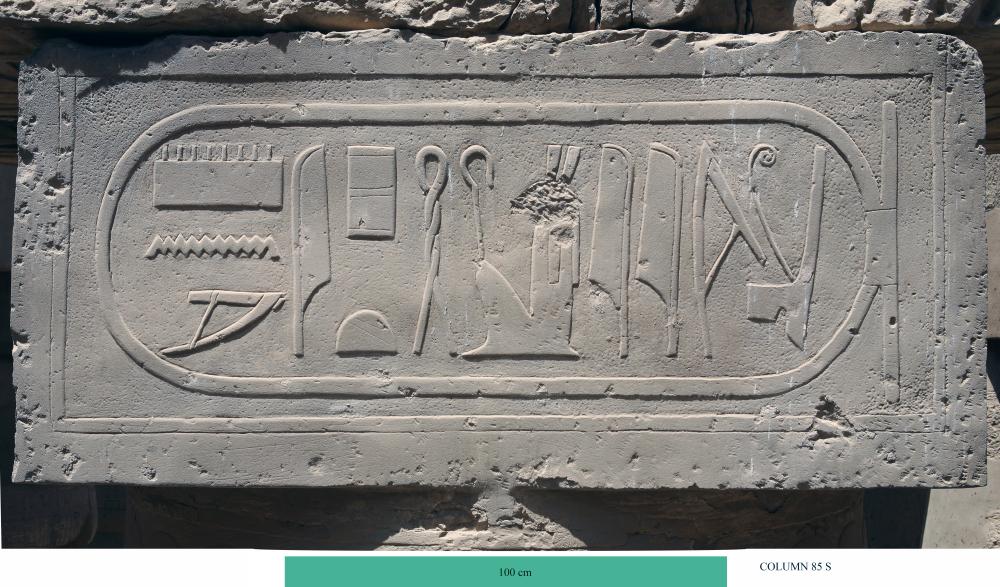
|
Fig. 3 : Scaled photo of Sety I nomen cartouche on abacus 85 south. Iconoclasts have defaced Seth's head. |
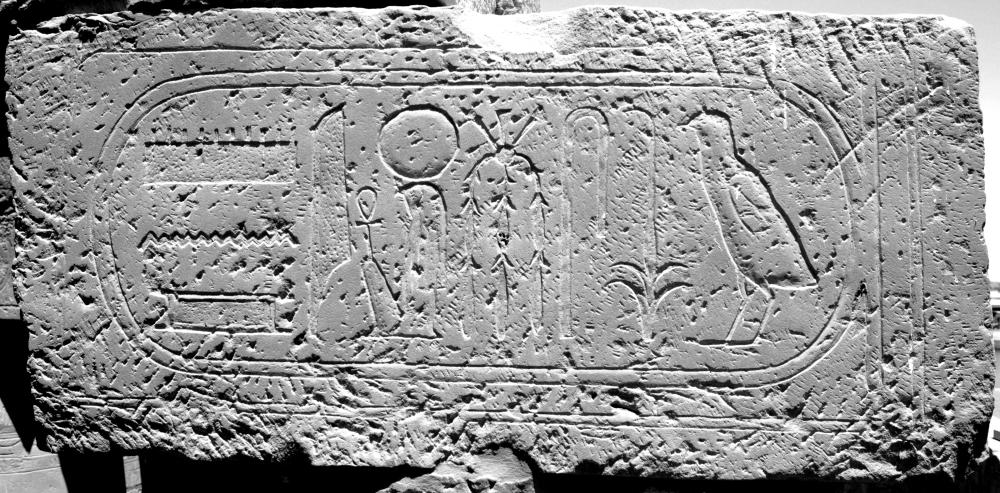
|
Fig. 4 Unscaled photo of Ramesses II sunk relief nomen cartouche on abacus 15 west. |
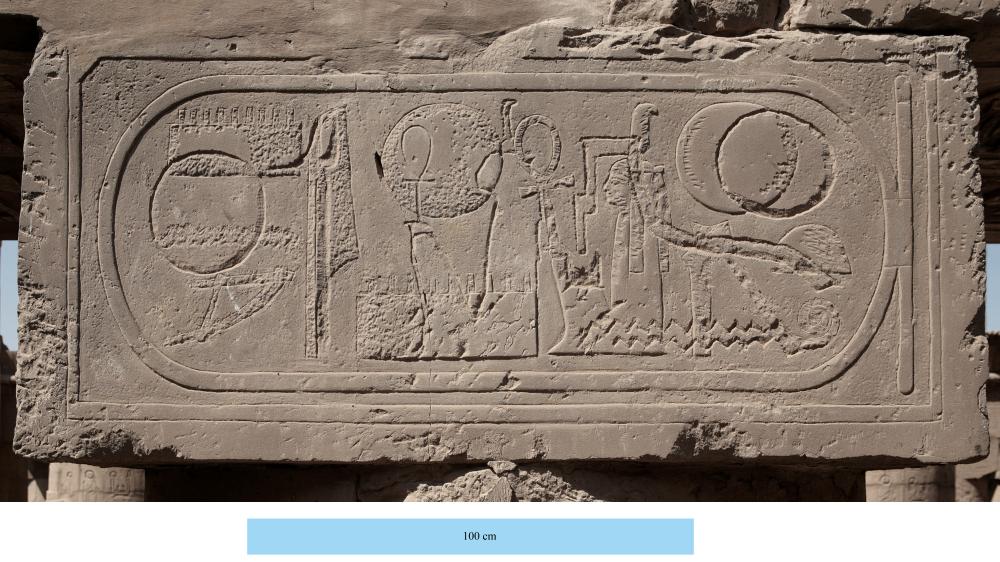
|
Fig 5 : Scaled photo of usurped Sety I prenomen cartouche on abacus 78 north. |

|
Fig. 6 : Scaled photo of Ramesses II palimpsest prenomen cartouche on abacus 17 west. Cf. fig. 8. |
We are using these scaled photographs to make facsimile drawings of these facets with Adobe Illustrator software (figs. 7-8).

|
Fig 7 : drawing of usurped Sety I prenomen cartouche on abacus 78 north. |

|
Fig. 8 : drawing of palimpsest Ramesses II prenomen cartouche on abacus 17 west . |
Theodolite Measurements of the Abaci, Clerestory and Walls
Since photography of all four facets of each of the 117 standing abaci from our scaffolding was impractical, we decided to employ a method developed by the CFEETK to produce orthostatically corrected photographs based on survey points taken with a theodolite and processed through the software program Redresseur developed by Yves Egel (ENSG/IGN). Dr. Cédric Gobeil measured points on most of the abaci in the Hypostyle Hall by this method using a Leica TCRP 1202+ R400 Total Station laser theodolite kindly lent to us by the Franco-Egyptian center. In collaboration with our colleagues at the Center who use this technique, Dr. Gobeil was able to test this method for rectifying photographs taken from the ground to make them appear orthogonal as if they had been taken directly in front of the abacus. If we are able to employ this technique on a widespread basis, it will be unnecessary to photograph the abaci from our scaffolding in the future.
As a first step, we took points on each abacus with the Total Station theodolite. Our goal was not to establish the exact position of each abacus within the general topographic system of the Great Hypostyle Hall, therefore, we did not have to place the Total Station on specific bench mark positions established in previous surveys. Instead, we were able to set the theodolite wherever we had the best possible view of the abaci— that is to say locations offering the smallest vertical angle in the device's view of the abaci. To achieve this, we decided to use the Total Station from the top of the walls surrounding the Hypostyle Hall (the North and South walls and atop the Second and Third Pylons) and by setting it between two rows of columns. In this way, we were able to treat a large number of abaci from each spot.
Once we set the theodolite in place, we had to pinpoint six precise points on each abacus face using specific points on the hieroglyphic signs as landmarks. Here, precision was key to the success of this operation; therefore, we had to choose signs that had at least one sharp angle, like one corner of the mn sign or of the iri sign. To maintain a high level of precision, we worked with Caminos' drawings of the abaci on which we marked all the points we measured with the Total Station. After we recorded these points, the second step of the process was to upload all these data points and sort them in a computer at the CFEETK using Covadis software. The Covadis program is able to render both two-dimensional (2D) and three-dimensional (3D) virtual models that show the real distances between all the points.
We assigned each point a unique number that marked its location on each abacus facet. For example, we gave the first point taken on the west face of the abacus atop column 134 the number 134w1, the second point 134w2, etc. Next, we manually placed all of these calculated and named points on their corresponding location on each of our non-orthogonal photographs with the help of the software program Redresseur. The Caminos drawings were very useful for placing each named point in the exact position on the photograph that we had taken on the abacus with the Total Station. To ensure the highest degree of accuracy, we enlarged the images using the zoom feature of the Redresseur software in order to place the points on the image precisely. Once we had marked all six named points on the original picture, the Redresseur software was able to link these named points with the same ones we had previously calculated with Covadis and thereby to straighten the picture, giving it the appearance of an orthogonal image (figs. 9-10).

|
Fig. 9 : Sety I prenomen cartouche on Abacus 134 west, before rectifying the image with Redresseur software. |

|
Fig. 10 : corrected photo of abacus 134 west. |
We also applied the same method (with six points taken) to scenes carved on the tall piers of the clerestory windows located above the central nave of the Hypostyle Hall,2 and on inscriptions on the very tall and narrow pilasters on the vestibule of the Third Pylon inside the Hall.3 These pilaster texts were so long and tall that we had to take three pictures of each and stitch them together using Photoshop. We were able to measure all these points from the top of the southern wall of the Hall as well as from the ground. These two other architectural elements were not too difficult to measure since they are flat; therefore, we only had to straighten the pictures using the same process we used for the abaci.
Epigraphic Findings on the Abaci Decoration
Palimpsests
Although they appear simple at first glance, the relief decoration on the abaci proved to be highly complex. Each abacus block in the Hypostyle is roughly square in plan with each of its four lateral sides having long rectangular panels decorated with large horizontal cartouches of Sety I or Ramesses II. In every case, both the nomen and prenomen cartouches of Sety I and Ramesses II have the epithet mr-Imn, "beloved of Amun" written with the hoe or canal hieroglyph (figs. 3-8) In addition to the invariable epithet mr-Imn, Sety I appended a second epithet to his "standard" prenomen Mn-MAat-Ra, placed at the flat, tail-end of the cartouche (fig. 10). Most commonly this is tit-Ra "image of Re"; iwat-Ra "heir of Re"; or iri-n-Ra "whom Re created." Rarely, others appear including HqA-WAst "ruler of Thebes"; HqA-Iwnw "ruler of Heliopolis"; or stp-n-Ra "whom Re chose" (fig. 11).
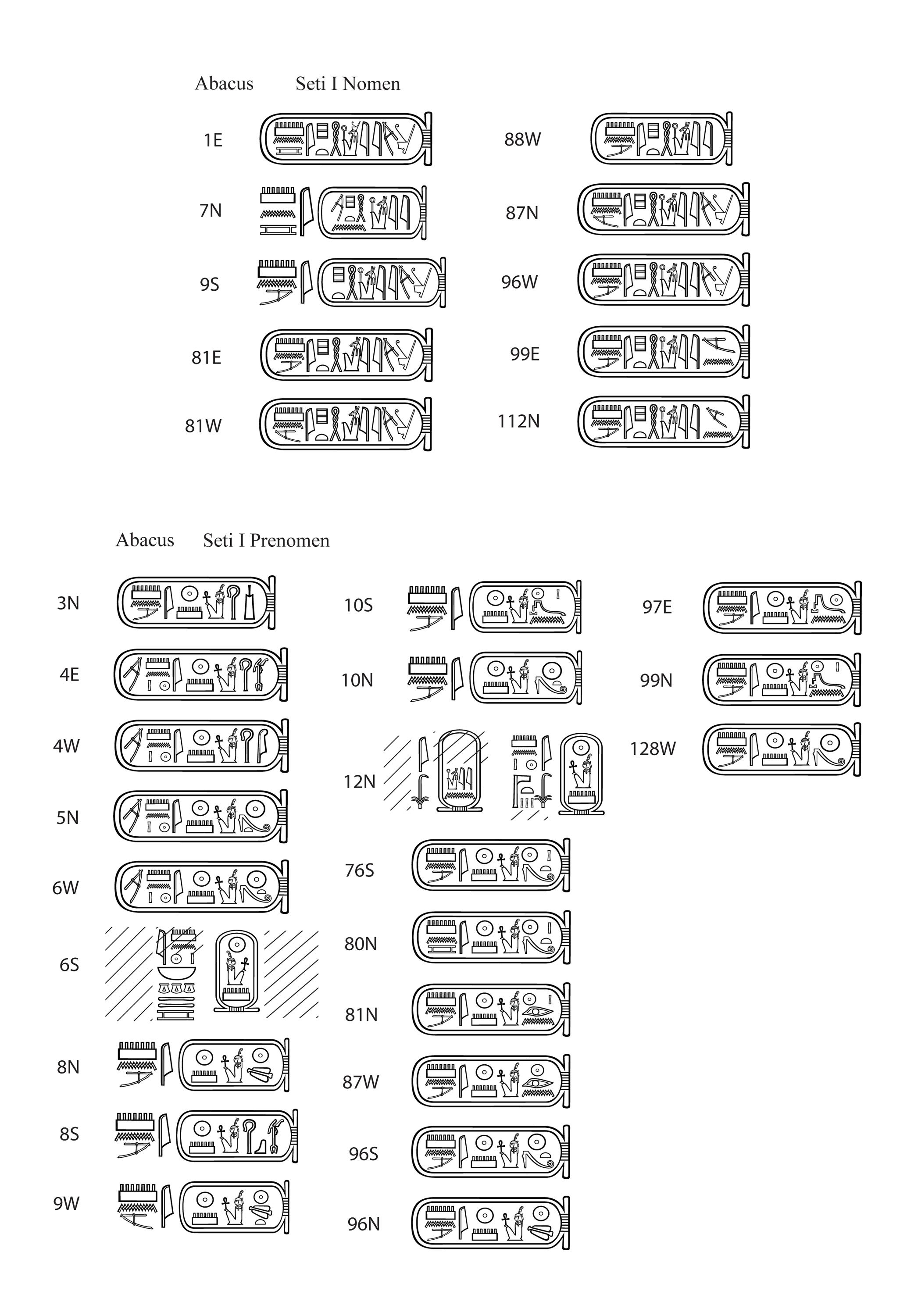
|
Fig. 11 : Sety I abacus cartouche variants. |
Ramesses II used the same system of epithets in his earliest abacus inscriptions which were carved in raised relief along the two main axes in the southern part of the Hypostyle Hall during his first year as king (fig. 12).

|
Fig. 12 : Ramesses II abacus cartouche variants. |
In this period, Ramesses II decorated the abaci in the first row of smaller columns south of the central nave (Columns 67-73) and those along the north-south axis of the south wing (columns 16-17, 25-26, 43-44, 52-53, 61-62). These early cartouches have his nomen written invariably as Ra-ms-sw-mr-Imn. His prenomen Wsr-MAat-Ra has one of the following epithets: tit-Ra, iwat-Ra, iri-n-Ra or very rarely stp-n-Ra. This pattern of epithets is clearly derived from Sety I's examples.
Twenty six abacus blocks in the Hall contain palimpsest cartouches on each of their four facets. In every case, the final inscription has the cartouches of Ramesses II carved in sunk relief using the longer form of his prenomen Wsr-MAat-Ra-stp-n-Ra which he adopted sometime during his second regnal year. However, both the original raised reliefs in these palimpsests and the final form of Ramesses II's nomen cartouche varies from case to case.
Ramesses II's conversion of his own raised relief abaci decoration
By the end of his first regnal year, Ramesses II began to carve his inscriptions in sunk relief and he soon adopted the definitive long prenomen Wsr-MAat-Ra-stp-n-Ra (fig. 5). He then erased his own early raised reliefs on abaci in the south wing and recarved all of them in sunk relief4 with his final prenomen replacing the earlier variants and with his nomen written Ra-ms-s instead of Ra-ms-sw (figs. 12, 13 and 14).5

|
Fig 13 : Original cartouche of Ramesses II with early R'-ms-sw spelling (Ab. 13 east). |

|
Fig. 14 : Palimpsest cartouche of Ramesses II with later R'-ms-s orthography over original cartouche of Ramesses II with early R'-ms-sw spelling (Ab. 44 east). |
Ramesses II's usurpations of Sety I's Abaci
A second group of palimpsests occurs on the first row of abaci north of the central axis (cols. 74-80) (figs. 5, 7).6 Sety I originally decorated these abaci with his cartouches, but Ramesses II later erased his father's names and replaced them with his own in sunk relief. We discovered that Ramesses II did this in the later years of his reign, sometime after his 21st regnal year when his nomen had once again become Ra-ms-sw-mr-Imn in Upper Egypt. The sculptors who did this were hasty in their work. Typically, they had shaved back Sety I's bas-relief incompletely and etched Ramesses II's names in a crude fashion quite distinct from his more elegant sunk relief elsewhere in the Hypostyle Hall. Attesting to this haste, on the north face of abacus 80 they recarved Ramesses II's prenomen incompletely (fig. 15).

|
Fig. 15 : Palimpsest abacus 80 north (partially recarved). Cf. Fig. 5 for parallel of a completely recarved cartouche. |
We suspect that these usurpations of Sety I's cartouches on this row of columns was part of his larger program to annex all the cartouches in decoration along the main processional axis of the Second Pylon and central nave of the Great Hypostyle Hall in preparation for one of his jubilee festivals.7
Orientation of cartouches
Each facet of the abaci contains a single cartouche with the nomen or prenomen of Sety I or Ramesses II, together with the epithet mr-Imn. Of great significance is the orientation of this theophoric epithet naming Amun inside the cartouche, which is systematically written in the opposite direction from the remaining signs of the pharaoh's name, both for the nomen and prenomen cartouches (fig. 16).
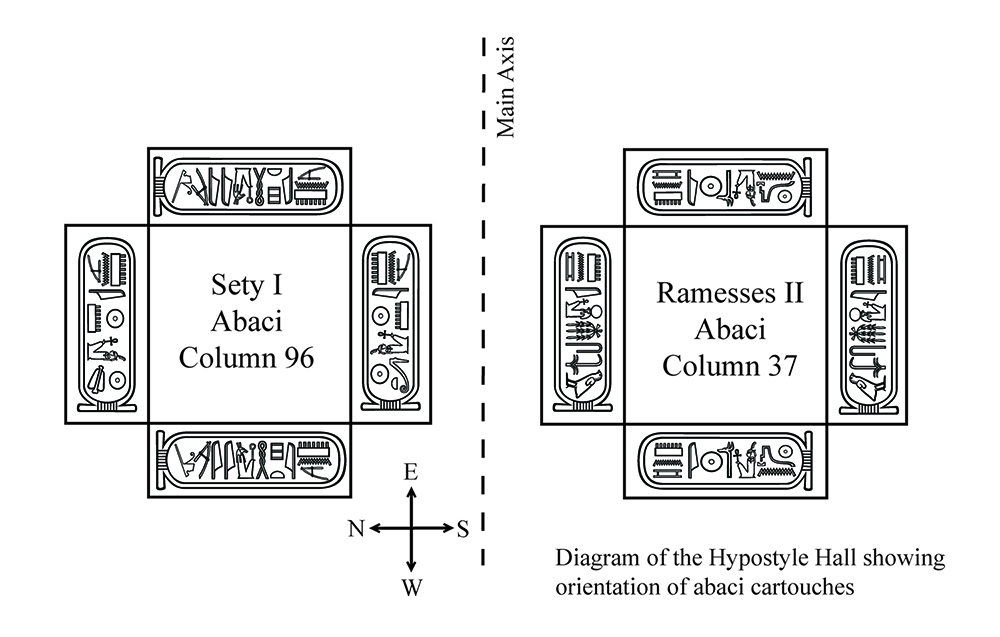
|
Fig. 16: Typical orientation of abacus decoration in the Great Hypostyle Hall. |
In almost all cases, the name of Amun faces towards the outer limits of the temple. So in the southern wing of the building, mr-Imn faces towards the South (on the East and West facets) or West (on the North and South facets). In the northern half of the Hall, the orientation is reversed, with the epithet facing North (on the East and West facets) and West (on the north and south facets). This implies that the prenomen and nomen of the king face in the opposite direction, viz.: towards the inner limits of the temple, that is to say North and East in the southern half of the Hall; but South and East in the northern half. Such orthographies mimic wall scenes in which pharaoh and deity confront each other during the ritual. Generally, wall scenes were carefully oriented in the same manner so that the king stood as if entering the temple from the outside and looked inwards to the sanctuary where the god dwelled forever looking out. Moreover, as Spieser has shown, the royal names, especially cartouches, could represent the royal presence by themselves in absence of his anthropomorphic image.8
On a few abaci, discrepancies are noticeable in terms of the orientation of cartouches (fig. 17).
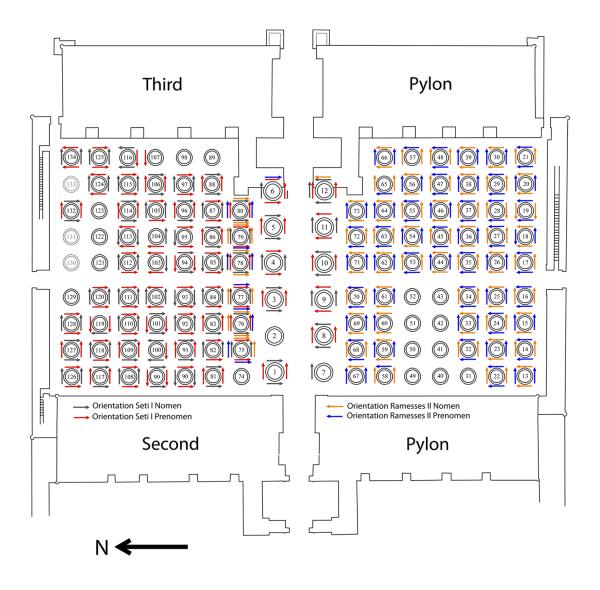
|
Fig. 17: Diagram showing orientation of abacus cartouches in the Hypostyle Hall. |
In the southern part of the Hall, on abaci 18N, 19N, 19S and 28S, the two elements of the cartouches are reversed so that in these four isolated cases, the phrase mr-Imn faces towards the inner part of the temple to the East, instead of the West (fig. 18).
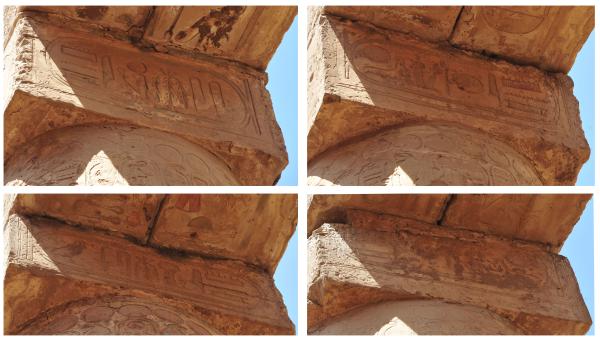
|
Fig. 18 : Discrepancies in orientation of cartouches (from left to right ab. 17-20 north). |
Are these exceptions to the rule the results of mistakes made by the artists? If this be the case, considering the high number of inscribed abaci facets originally in place — amounting to more than 500 cartouches— the resulting percentage of mistakes would total less than 1%. It is hoped that further study will reveal whether this localized cluster of exceptional abaci are simply a fortuitous error or part of a deliberate plan.
Normally, each abacus block contains two prenomen and two nomen cartouches of the king engraved alternatively on each facet of the block. In some cases however, there are further anomalies. For instance, on the abaci of columns 76 and 79, we find three nomen cartouches and just one prenomen. Adjacent to the former, column 75 does have the expected two prenomen and two nomen, on its four sides, but each type of cartouche appears on the "wrong" facet when compared to others nearby.
Paleography
A paleographical survey of the signs on the abaci revealed interesting details. For instance, it is quite obvious that more attention was paid, aesthetically speaking, to engraving the cartouches that were more clearly visible from the main axes of the Hall, than those that were concealed from viewers in the main aisles. A good case in point are abaci that face East in the two rows of columns in the southern half of the Hall that were furthest away from the secondary North-South axis. In many cases, such as on abacus 29E, the quality of workmanship leaves much to be desired.
Another feature worth mentioning is the way the size and shape of signs inside a cartouche may be determined by the size of the abacus. For example, on abacus 126N, all the vertical signs look particularly narrow and attenuated since they had to be squeezed into a shorter cartouche ring.
It is also interesting to note that some particular signs can show a great variety of shapes. Thus, examples of the iwa-glyph (Gardiner Sign List F44) display many subtle variants: the amount of meat on either side of the bone or the length and shape of the bone itself (especially its bulbous tips) can vary quite significantly from one example to the next (fig. 19).

|
Fig. 19 : Composite photo of variants of iw'-sign (Gardiner Sign List F 44). |
One almost has the feeling that there was not yet a canonized version of this hieroglyph. Even signs that are quite standardized like the mn-sign (Gardiner sign list Y5) display a fairly wide range of variants from one abacus to the next, even when they are used within the same pattern of the arrangement of signs. Thus the number of game pieces resting on top of mn varies from as few as five to as many as ten, with apparently greater variability under Sety I than Ramesses II (fig. 20).

|
Fig. 20 : Composite photo of variants of mn sign (Gardiner Sign List Y 5). |
Other signs, like the mr-canal (Gardiner sign list N36) seem to display various stages of completeness (fig. 21). Finally, some identical signs sharing common morphological features are concentrated in specific areas of the Hall. For instance, on abaci 126E, 127E and 128E, the mr-hoe (Gardiner sign list U7) is uncharacteristically short, especially in comparison with the example on abacus 93N.

|
Fig. 21 : Composite photo of variants of mr sign (Gardiner Sign List N 36). |
Documentation of the Column Scenes
One of the main goals of this season's epigraphic work was to begin recording the ritual scenes present on the 127 standing columns in the Great Hypostyle Hall. During the 1950s, Harold H. Nelson created sketches of this decoration, but his drawings are highly schematic and preliminary and are not true facsimiles (figs. 22-23).
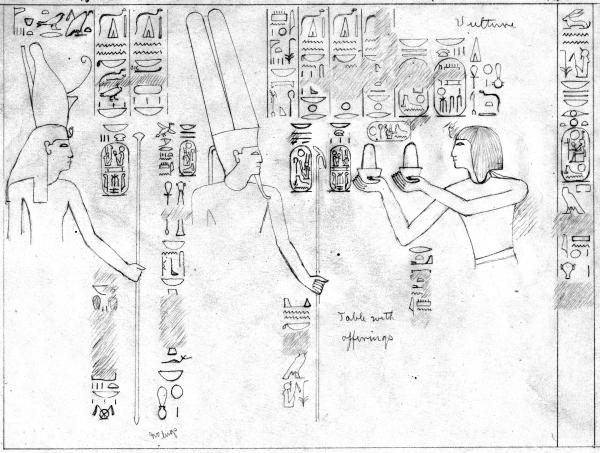
|
Fig 22 : Nelson's sketch of a scene of Ramesses II on column scene 17 B. |
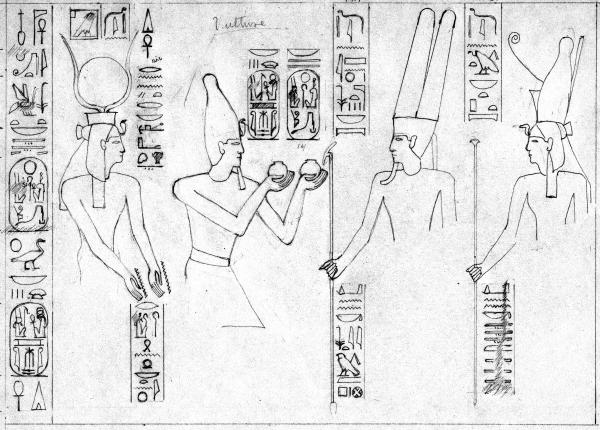
|
Fig. 23 : Nelson's sketch of a scene of Ramesses IV on column scene 83 C. |
He drew them as freehand sketches on graph paper without the aid of a photographic base that he had previously employed when he drew scenes on the interior walls of the Hall. The curvature of the column surfaces makes orthogonal photography impractical and Nelson's Chicago House method impossible. He copied these column scenes in the years immediately before his death in 1954, by which time he appears to have completed drawings of all the 122 closed bud column scenes, but he never recorded those on the twelve great columns of the central nave. Thereafter, his sketches lay forgotten among his papers in the archives of the Oriental Institute in Chicago until we rediscovered them in 2009. Nelson's objective was mainly to provide hand copies of the texts and some basic iconographic data from the scenes including the king's ritual act along with his crowns and regalia and those of each deity present in the scene. Many details of the reliefs are wholly absent or at best highly abbreviated, including any offering table as well as the lower bodies and usually the garments of both the king and the gods. Any falcon or vulture that frequently appears above pharaoh's head— where noted schematically in the drawings— is not rendered in any detail. Nelson's sketches also omit much epigraphic data such as iconoclastic hacking, quarry damage, recutting, plaster and paint, or graffiti.
Despite their limitations, Nelson's drawings are a remarkable achievement and stand as the only comprehensive attempt to record the huge body of over 350 separate column scenes in the Great Hypostyle Hall systematically.9 An objective during this season was to collate Nelson's drawings against the originals both to check the accuracy of his copies and to document the epigraphic and iconographic data that he overlooked.
Our epigraphic method consisted of editing and annotating blueprints copies of Nelson's drawings against the original scenes using a system of collation modeled on the Chicago House method. On these sheets we recorded the iconographic characteristics of the pharaoh and deities, along with the presence of paint, iconclasm and recutting. Given the daunting scale of our task, these efforts were preliminary, but we were able to collate several dozen column scenes. Besides notes and drawings, the expedition also made detailed photographs of the column scenes which will further aid our research. We also made initial hand copies of all the caption texts from the 36 scenes on the twelve great columns of the central nave.
A further goal was to clarify our understanding of a number of chronological and epigraphic features of the column decoration. Amongst our findings, we verified the fact that all of the scenes showing Ramesses II present on the 12 great columns of the central aisle and the scenes on the small columns lying on the south half of the secondary North-South axis (columns 16-17, 25-26, 34-35, 43-44, 52-53, 61-62, 70-71) had originally been carved in the earliest part of his reign in raised relief but were later converted to sunk relief after he had adopted the long form of his prenomen cartouche. It is likely, too, that Sety I had created the painted drafts for these column scenes but his artists had not yet carved them in relief before his death.10
The expedition also made detailed notes and sketches of palimpsests scenes found on columns 74-80, the first row of smaller columns north of the nave. Sety I had decorated these columns in bas relief, but Ramesses II later recarved them in sunk relief and re-inscribed the cartouches in his own name. Generally, Ramesses simply transformed Sety's raised decoration into sunk relief by cutting over the earlier designs. It is likely that Ramesses II's usurpations date no earlier than his 21st regnal year, and were probably effected on the occasion of one of his jubilees, since his nomen is always spelled Ra-ms-sw.11 Hallmarks of this work are Ramesses' unusually large cartouches. In rescaling them, his sculptors were forced to make considerable alterations to Sety I's decorative scheme. Often, this led to the suppression of entire columns of raised relief texts. In at least one case, an ointment jar statuette the king offers to Amun was modified from a kneeling king to a crouching sphinx to accommodate the larger cartouches (figs. 24-25).
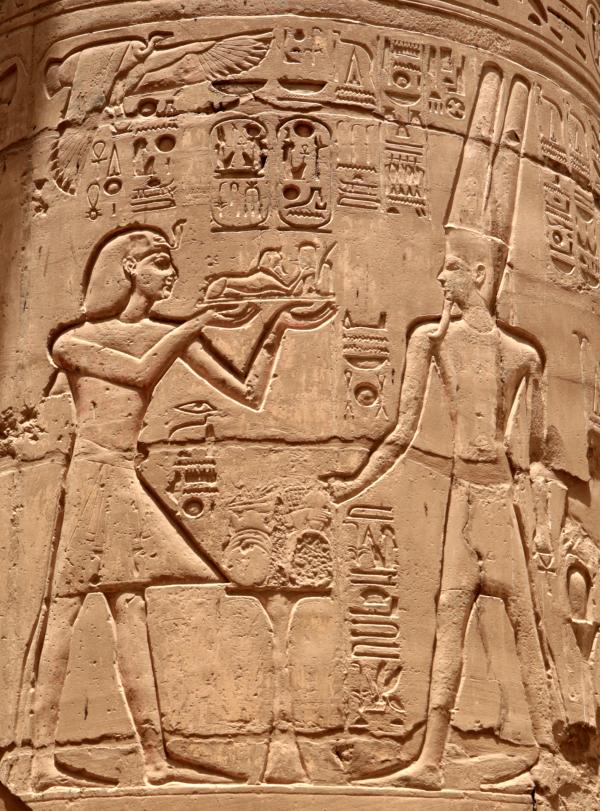
|
Fig. 24 : Palimpsest relief from column 80A showing decoration of Sety I recarved as sunk relief by Ramesses II. |
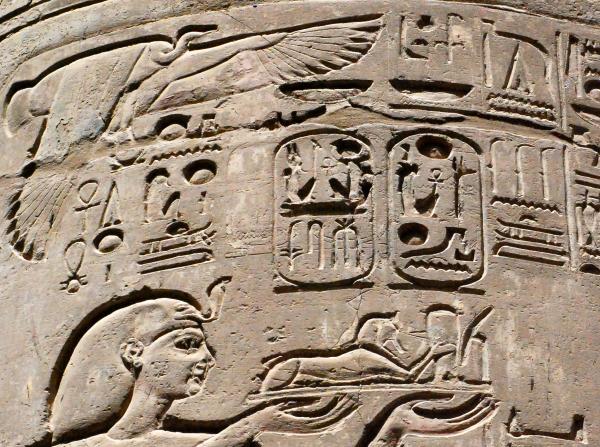
|
Fig. 25 : Detail of column scene 80 A showing palimpsest. |
System of Decoration and Orientation of Scenes
The decoration of the Hypostyle Hall columns was begun during the reign of Sety I. Before his death, he had inscribed all of the columns in the North wing located on either side of the secondary North-South axis. Each of these columns received an offering scene oriented towards this axis (fig. 26).
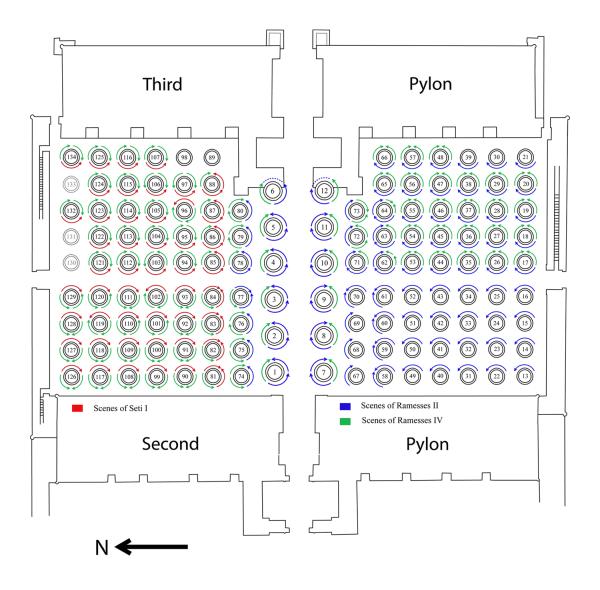
|
Fig. 26 : Orientation of scenes in the Hypostyle Hall. Red arrows indicate scenes of Sety I, blue are Ramesses II and green represents Ramesses IV. The arrow points indicate the direction the king is facing. |
These are columns 81-134, except for col. 89, 98, 130, 131 and 133 that are no longer in situ. In the case of the columns of row 74-80, Sety added a second scene oriented towards the central East-West axis. He did the same with the southern face of columns 74-80 which were later usurped by Ramesses II, as well as with the eastern face of col. 77 and the western face of col. 78. In each of the scenes that Sety I carved in raised relief, the king offers to gods, usually Amun-Re or another male accompanied by a consort goddess, or less often a second male deity.12 On the great columns and in the South wing, Ramesses II went on to engrave similar scenes that also typically feature Amun-Re or another male deity usually followed by a goddess. In at least one case (column 13), however, the deified Sety I himself stands behind Amun-Re.
In their initial decorative state, the columns had only one or two scenes as in similar closed-bud papyrus columns in contemporary monuments like Sety I's Gurnah temple, the Ramesseum and Ramesses II's peristyle forecourt at Luxor Temple (figs. 27-28).
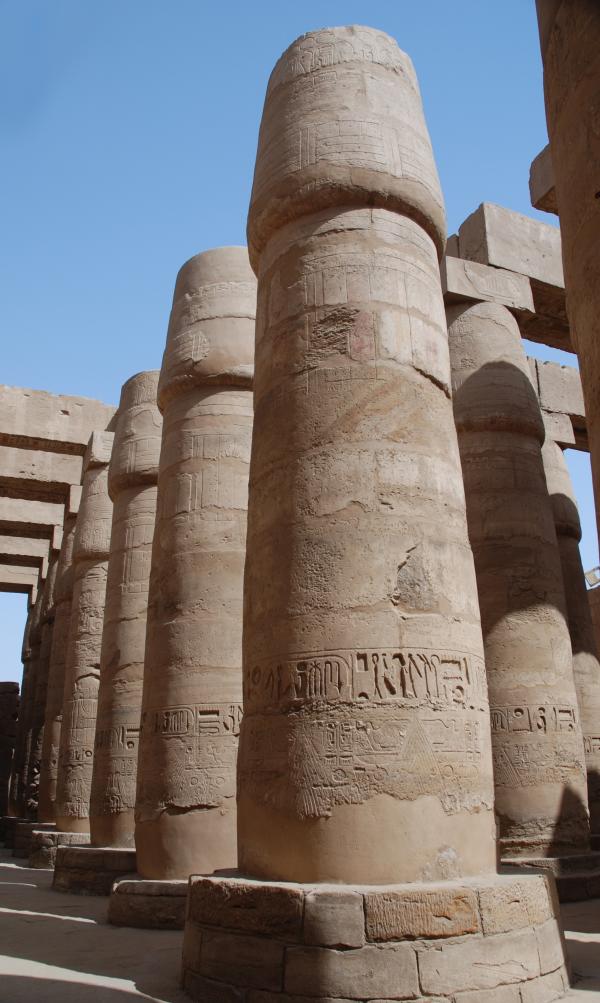
|
Fig. 27 : Undecorated sides of columns in south west quadrant of the Hypostyle Hall. |
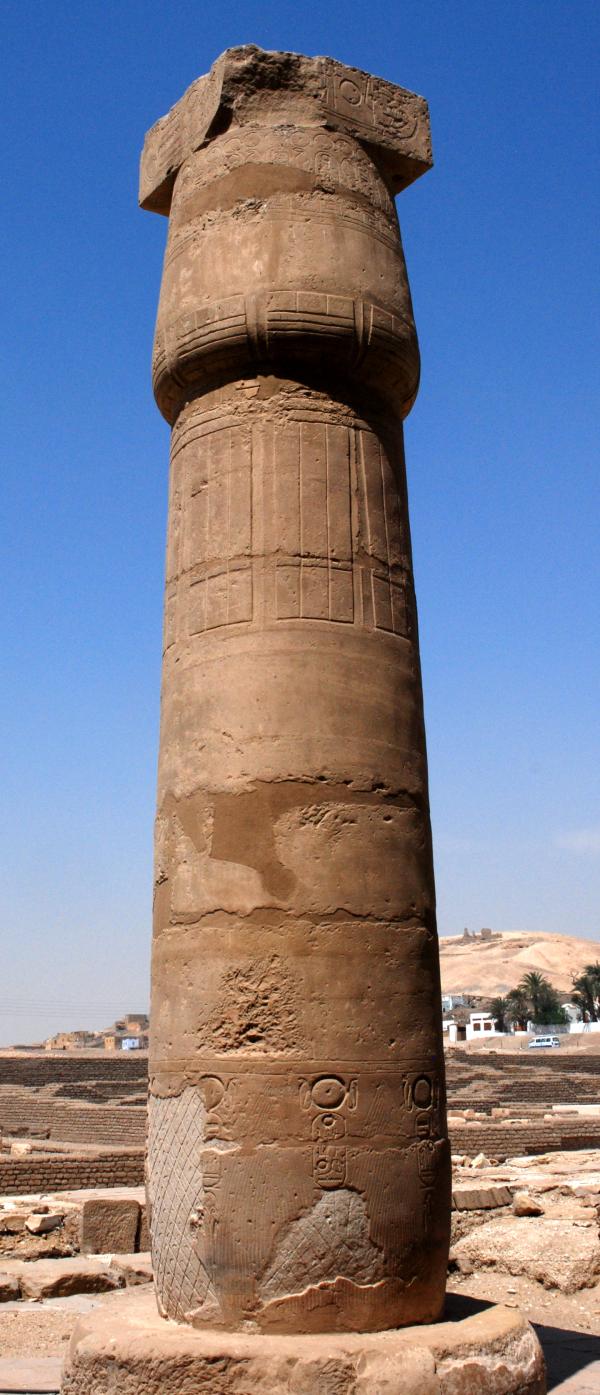
|
Fig. 28 : Undecorated side of a column in the second hypostyle hall of the Ramesseum. |
Otherwise, the midsections of the Great Hypostyle Hall's columns were devoid of further decoration until Ramesses IV inserted additional scenes— usually two per column where space was available— on the surfaces of the columns facing toward the exterior of the temple and counter to the orientation of the two main axes of the Hall (fig. 26).13 Ramesses IV never completed this project so there is a cluster of columns in the South-West quadrant of the Hall and two more shafts in the South-East corner lacking his additional scenes. Ramesses IV proved to be more creative than his predecessors in the layout and iconographic design of his scenes. Thus, the number of gods represented varies from just one to as many as four. Occasionally a secondary deity stands behind the king, a feature never seen under Sety I and Ramesses II.
Under Sety I, the orientation of the scenes is almost uniformly systematic. With the exception of column scenes 102A and 119A, the king always faces towards the South, i.e., towards the interior of the Hall, while the gods look towards the North. In the case of column 96, Sety's relief is engraved on the eastern side of the column, which is a mistake, however this is probably the result of an error by Legrain when he re-erected this column after it collapsed during the earthquake of 1899.14 Ramesses II followed his father's example by depicting his figure always facing towards the interior of Karnak temple, i.e., towards the north in the South wing, while on the twelve great columns he faces either towards the main axis or to the East.
Once again, Ramesses IV's column scenes differ from those of his Nineteenth Dynasty predecessors. Ramesses IV's image generally looks towards the West in the eastern half of the South wing of the Hall; the opposite being true on columns 72 and 73. Interestingly enough, it is near this part of the Hall (more precisely on columns 62 and 64) that Ramesses IV had two scenes engraved, instead of one, even though Ramesses II had already carved two scenes on these columns. Is this, perhaps, where Ramesses IV had begun decorating the columns? These exceptions might then be understood as part of his attempt to devise a system of decoration for parts of columns that were never originally intended to receive such additional scenes. On the other hand, Ramesses IV did not inscribe the northern half of the Hall in any systematic way either. Whereas scenes in parts of the western section of the North wing are oriented according to the same logic as in the South, other rows of columns to the East do not show the same mode of orientation.
Iconoclasm
Iconoclasm on the columns
As is frequently the case with almost all Egyptian monuments that were occupied by people during Coptic15 and later times16 , evidence for iconoclastic hacking of representations of living beings (whether human or animal) can be found amid the decoration of the columns17 (fig. 29).
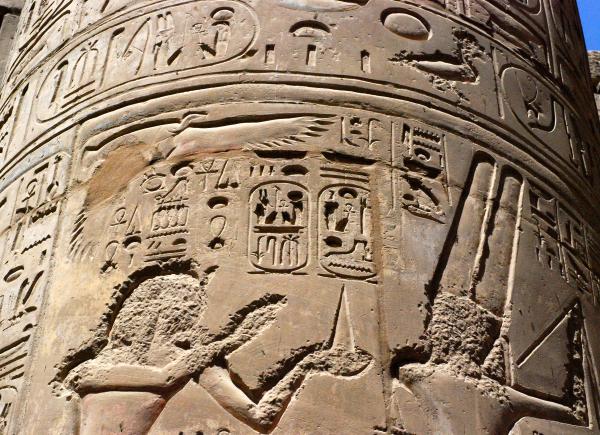
|
Fig. 29 : Typical example of iconoclasm on a column. |
Such defacement is detectable on the main royal and divine figures engraved in the scenes and on hieroglyphic signs in the caption texts. Areas inside the Hypostyle Hall where iconoclasm on the columns is concentrated can be divided up in two categories: the sections of the Hall close to the Second Pylon where late occupation (once the temple had been abandoned) is manifest18 and the sections of the Hall located near the two main axes.
1.1. Evidence of iconoclasm on the royal and divine figures inside the scenes
In most cases, iconoclasm takes the form of hacking to the royal and divine figures. Sometimes, the iconoclasts attacked only the faces. Various patterns of chisel blows are observable: the whole face may be hacked, the job having been done so meticulously that the outer contours of the profile and headdress remain clearly visible although interior details are obliterated (fig. 30).
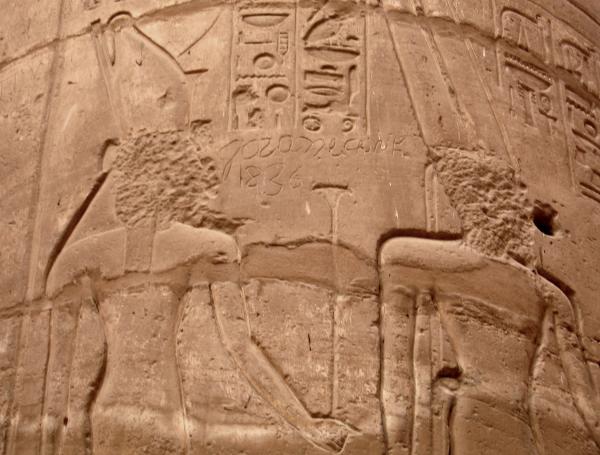
|
Fig. 30 : Iconoclasm with hacking carried out meticulously as to preserve contours of face. |
In other cases, the chisel men extended the zone of hacking to the negative space around the head in an indiscriminate fashion (fig. 31).
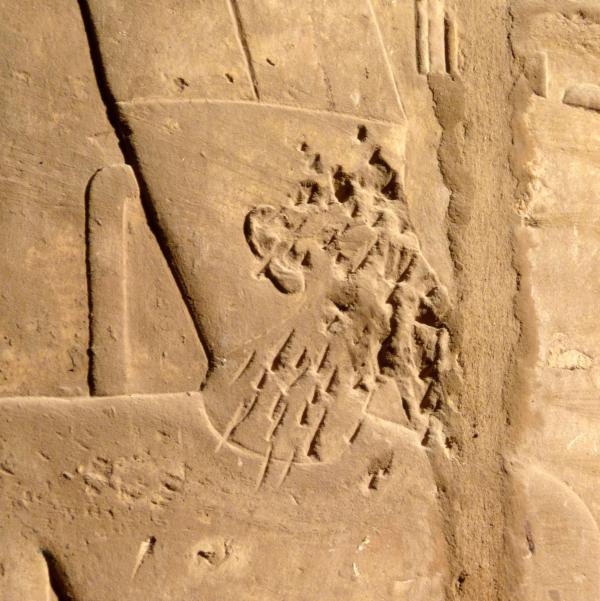
|
Fig. 31 : Iconoclasm with hacking carried out indiscriminately (col. 108a). |
In one instance, even Amun-Re's double-feathered crown was chiseled. Most examples show that the nose, eyes, mouth, ears and neck have been specifically targeted, in various combinations, presumably to render the images magically blind, deaf and dumb. In one case where the ear was not visible beneath the king's wig, the iconoclast deliberately cut out the section of the wig under which the ear would have lain.
In many instances, iconoclasts also targeted the limbs of pharaoh and the gods, again to render them magically harmless. Arms, legs and especially feet may be discretely cut away, very often with a high degree of precision. Hacking can sometimes be found on the articulations of limbs only (wrist, ankle, and elbow joints) so as to make the royal or divine figure powerless to act or move. Finally, on very rare occasions, the small Maat-glyph in the representation of pharaoh's offering Maat was also hacked out.
1.2. Evidence of iconoclasm in the hieroglyphic texts
This is particularly obvious in the case of the Maat-glyph engraved inside the prenomens of Sety I, Ramesses II and Ramesses IV, as well as the anthropomorphic or zoomorphic hieroglyphic signs referring to the gods Re and Amun that are frequently used in the cartouches and epithets of the royal titulary. Whether represented seated on a throne or squatting on the ground, these gods are very often defaced in some way, both in the small cartouches identifying the king above his effigy inside a scene or in the series of large horizontal or vertical cartouches of Ramesses IV that embellish the upper shafts and capitals of the columns (fig. 32).
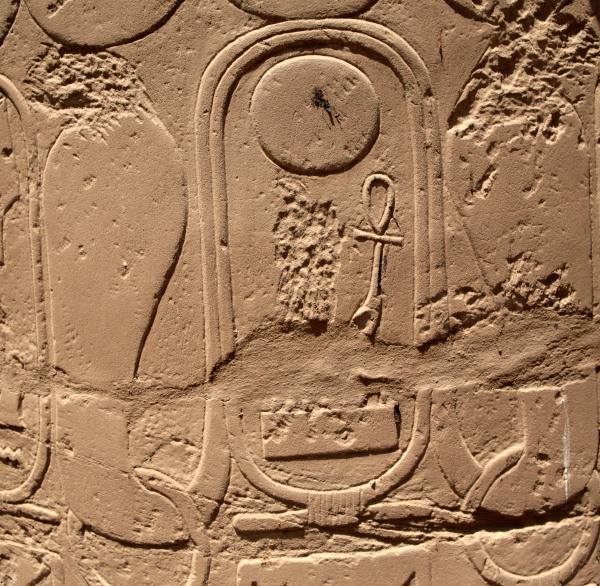
|
Fig. 32 : Hacking of mAat figure and sign on upper partof column shaft. |
Iconoclasts could go to great efforts to achieve their aims, as shown by mutilated cartouches located in positions very high above ground level, as on some abaci and architraves. In the case of the god Seth, the Seth-glyph representing him in the spelling of the name of Sety was also frequently removed, although there is some ambiguity as to whether this defacement happened in the Late Period when other images of the god were effaced inside the Hall or if the damage is post-pharaonic.19 Chisel marks in such cases, however, do not seem to differ from those used on other hieroglyphs, which would rule out (at first glance at least) the Late Period damnatio memoriae, when Seth had become a symbol of foreign domination over Egypt. The iconoclasts also destroyed in whole or in part anthropomorphic or zoomorphic representations of figures used in hieroglyphic signs. Bird hieroglyphs were frequently targeted by the image breakers (fig. 33); the same can be said of the seated king determinative in the word nsw. In the case of the birds, mutilation is limited to their heads and feet.
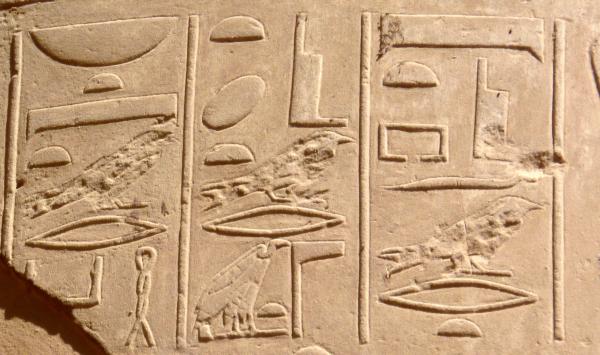
|
Fig. 33 : Hacking of wr bird (Gardiner Sign List G 36) on column 129a. |
The use of Orthophotography as a Means to "unroll" Columns
The aim of this part of the project is to produce an exhaustive and accurate orthophotographic documentation of all the columns in order to support epigraphic study as well as architectural analysis. Photographic unrolling of the decoration and frontal views oriented towards the four main directions are envisioned for each column (fig. 34).
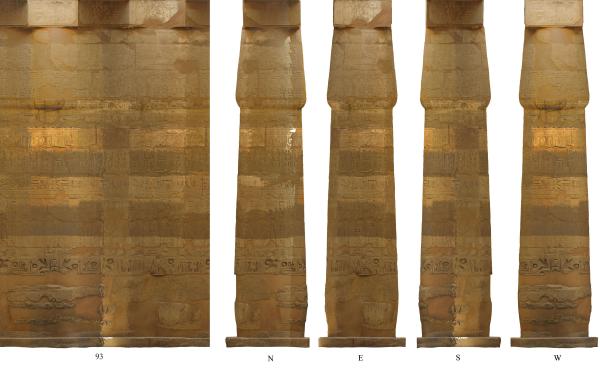
|
Fig. 34 : Unrolled image and four orthogonal views of column 126. |
The complete set of topographic and photogrammetric data required to produce such images was collected during two field campaigns in 2007 and 2008.20 The complete 3D model is currently ready while the photogrammetric data, collected during the second mission, is still being processed. With more than 4400 photographic images, this undertaking was tremendous. Optimized tools and procedures are regularly drawn up in order to take into account the repetitive context of the columns, thanks to the collaboration of Yves Egels (ENSG/IGN) and the support of the team at the Department of Imagery and Remote Sensing of that same institution.21 Each column has been photographed from 32 different positions - 40 for the tallest columns along the central axis- according to a protocol which guarantees a regular and optimal recovery of the pictures. This process, called aerotriangulation, consists of connecting identical points shown on different photos, in order to determine the orientation and precise location of the cameras in space. Some tasks, such as setting target points are done manually while others have been carried out semi-automatically, as is the case with the matching of common reference points on each image.22
While computation is rather fast, extra time is sometimes needed to detect "errors" and correct them. The parameters of 85 columns have already been calculated and validated, making it thus possible to generate their complete unrolling. Because Egyptian column shafts have a curved outline, it was decided to unroll the perpendicular projection of their image on a cylinder model. The orthophotography thus produced gives a complete overview of all the scenes, texts and decorative motifs engraved on an entire column, but the scale of representation is not always consistent. For example, the upper and lower parts of the shafts are represented with the same scale in spite of the difference in their circumference.
Once the photogrammetric parameters have been defined, any point of view of the object can be chosen, in perspective as well as in orthogonal mode. Longitudinal sections across the Hall which are particularly helpful for architectural and masonry analysis will be drawn. Architectural breaks or continuities on columns can then be highlighted, providing new information on either techniques of construction or the chronology of the building phases of the Hall. Are columns regularly arranged? How many rows of drums does each column consist of? Is there any matching of the courses' level from one column to the next?
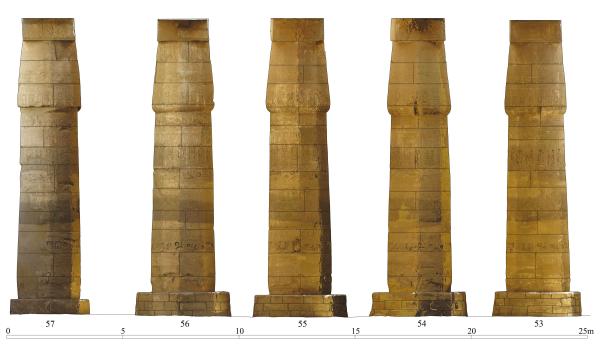
|
Fig. 35 : Orthogonal view of columns 53-57 showing the courses of masonry in each column. |
Fig. 35, for instance, which represents the northern elevation of columns 57 to 53, shows some interesting features. One notices, for example, that each column (drums and capital included) has an equal number of twelve courses which are respectively located at a fairly consistent height across all five of them. This coincidence is not surprising since the ground level was gradually raised in order to set up the blocks.23
The regularity of the masonry is also striking ; drums are systematically made of two half cylinder-shaped blocks joined together, that are rotated by a quarter turn at every course. Such observations suggest that the columns were raised in a same constructive phase,24 despite variable spans.25 Further analysis carried out in situ on other rows of columns inside the Hall will make it possible to put forward more definite conclusions.
Finally, among the greatest difficulties of photogrammetric recording, illumination was the most difficult feature to manage. It was in fact impossible to obtain homogenous lighting on cylindrical surfaces: some areas are directly under sunlight while others oriented to the north are always in the shade. These radiometric issues would have been solved by night shooting, associated with proper lighting; such process was unfortunately too complex and costly to be considered at the time. A compromise was to take all the pictures in the shade, even though such solution was unfavorable for recording some details. In spite of precautions taken while shooting the images, strong differences in contrast and color still remain on the pictures. These require radiometric corrections on the photographic assemblage of each column, as the treatment of a column in fig. 36 shows. A semi-automation processing system is being considered to solve this problem.
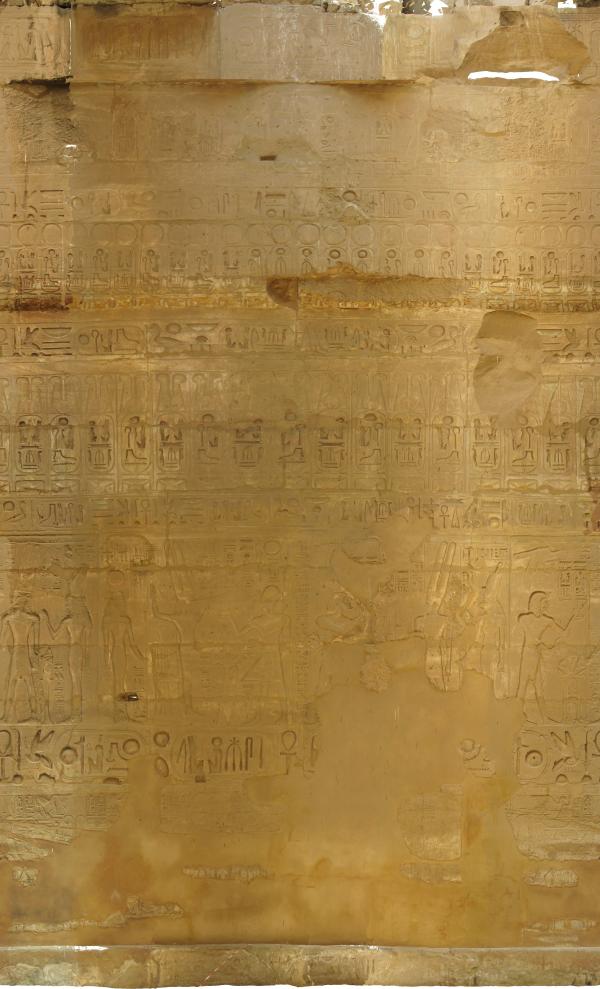
|
Fig. 36 : Unrolled image of column 108 after radiometric corrections. |
Recording of loose blocks from the Great Hypostyle Hall at Karnak
The study of loose blocks from the Hypostyle Hall was started by the late Dr. Murnane in the early 1990s. He selected 270 blocks in the open-air stores within the Karnak enclosure and mapped their locations. In 2000 he asked Dr. Janusz Karkowski to start systematic study of the blocks to add important information to the study of wall scenes and to determine whether it was possible to reconstruct individual scenes and establish their emplacement in the walls. This work continued in 2002 with Dr. Brand, who replaced Dr. Murnane after his death in 2000.
Dr. Karkowski's work added a considerable number of blocks to those identified by Murnane. Some blocks Murnane had listed were eliminated as not belonging to the Hypostyle Hall. Once systematic documentation the blocks started, we decided that whenever possible the decorated faces would be recorded photographically. In cases where blocks lay so closely together that it was difficult to access a particular block for orthogonal photography, it was traced on a transparent film at a 1:1 scale and then the tracing was photographically reproduced.
After 2002 a significant number of blocks were transferred by the French-Egyptian Centre to new mastabas in the north-eastern corner of the Karnak enclosure from a hill between the Great Hypostyle and the Ptah temple, where they has been stored in disorder thereby providing limited access to them. During the process, a few new decorated fragments were discovered that has previously been hidden in the ground. All the blocks were arranged on the mastabas so as to facilitate orthogonal photography.
During the 2011 season, Dr. Karkowski photographed the blocks using a high resolution digital camera and a lens with a focal length of at least 50 mm to avoid spherical distortion. An angular measure was placed at the level of the decorated surface to scale the images. This makes it possible to correct the angular (i.e. perspective) distortion of individual photographs, which under field work conditions are almost never perfectly orthogonal to the decorated surface. Additional control measurements taken previously and completed during this season permit the accurate scaling of these photographs. Altogether he recorded 154 decorated blocks coming from the walls.
Our study of the blocks is ongoing, but at this preliminary stage we have established the exact position of some of the blocks in the walls. The most spectacular example is the restoration of the inner (southern) face of the lintel above the doorway in the middle of the north wall (fig. 37-38).
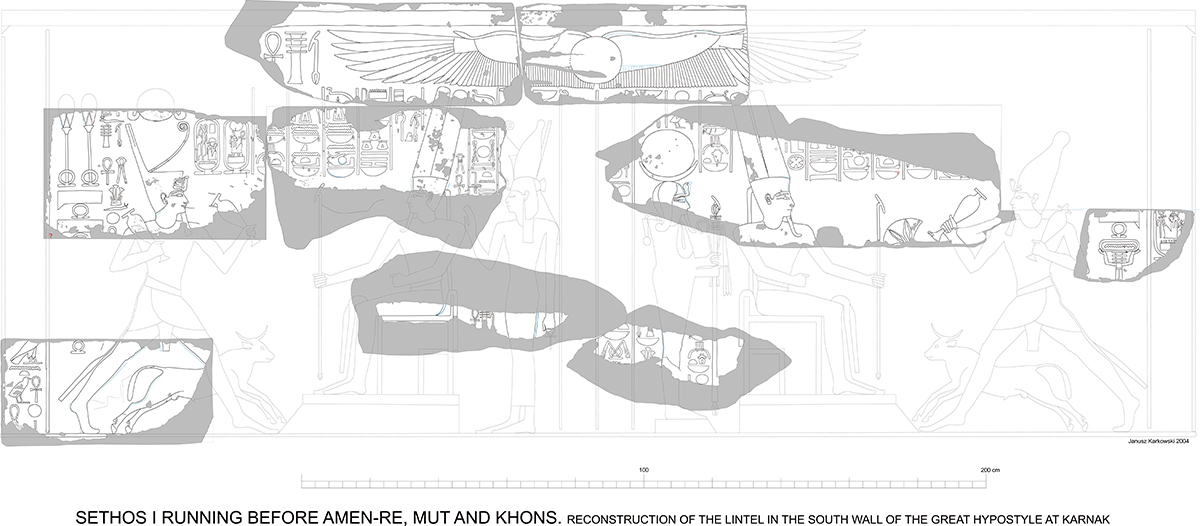
|
Fig. 37 : Scene from the lintel of the north gateway reconstructed from blocks. Drawing by J. Karkowski. |
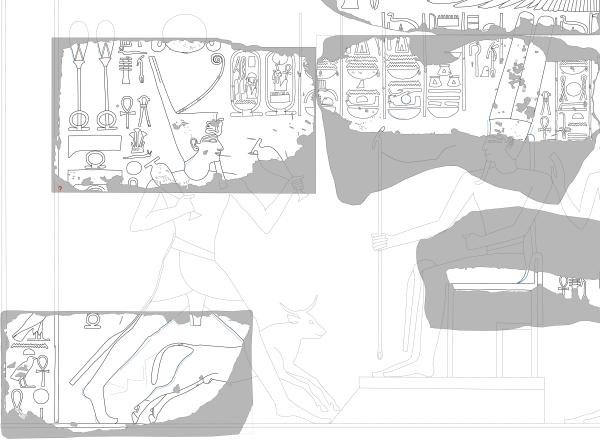
|
Fig. 38 : Detail of reconstructed lintel. |
Another architectural element established up to now are two windows in the east wall by its south and north ends, which brought additional light to the aisles of the Hall most distant from the clerestory windows of the axial processional way (fig. 39). Of the partly preserved walls the best prospect of restoration are in the case of the uppermost register of the south wall.26
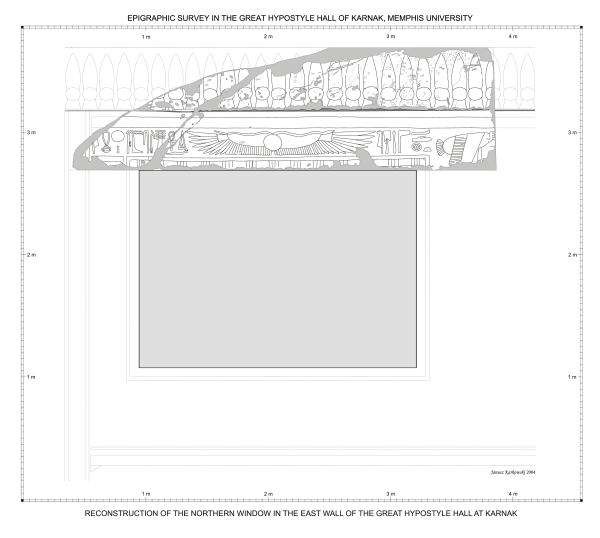
|
Fig. 39 : Reconstruction of a window in the north half of the east wall. Drawing by J. Karkowski. |
Notes
[ 1 ↑] The Karnak Hyposytle Hall Project is led by Dr. Peter J. Brand, Director (University of Memphis) and Dr. Jean Revez, Co-Director (Université du Québec à Montréal). The staff included Egyptologists Dr. Janusz Karkowski (Polish Academy of Sciences), Dr. Cedric Gobeil (IFAO/UQAM) and our photographer Mr. Richard Fero. Our graduate students from the University of Memphis and the Université du Québec à Montréal were Ms. Erika Feleg, Ms. Laura Glymph, Mr. Mark Janzen, Mr. Guillaume Bouchard Labonté, Ms. Nancy Moreau, Ms. Perrine Poiron and Ms. Tiffany Redman. Our reis was Mr. Mohamed Faruk, assisted by his team of workmen.
[ 2 ↑] Nelson, Key Plans, pl. 4, figs 1-4; PM II2, p. 50.
[ 3 ↑] Located at Nelson, Key Plans, pl. 4, figs. 8b and 12b; loc. KB 172 and 355. Both pilaster facets are decorated with the names and titles of Sety I (KB 172) or Ramesses II (KB 355). They were not recorded in Nelson and W. J. Murnane, The Great Hypostyle Hall at Karnak, vol. I, part 1, The Wall Reliefs, OIP 106, 1981, hereafter GHHK I.1. These pilasters will appear in a forthcoming volume of translation and commentary to GHHK I.1.
[ 4 ↑] This pattern of converting bas relief decoration into sunk relief is well known from the wall reliefs on the south half of the west wall and the west half of the south wall of the Great Hypostyle Hall. See K. C. Seele, The Coregency of Rameses II with Seti I and the Date of the Great Hypostyle Hall at Karnak, SAOC 19, 1940, p. 50-60; W. J. Murnane, « The Earlier Reign of Ramesses II and His Coregency with Sety I », JNES 34 (1975), p. 170-180; P. J. Brand and W. J. Murnane, The Great Hypostyle Hall at Karnak, Vol. I, part 2, The Wall Reliefs: Translation and Commentary, forthcoming.
[ 5 ↑] The nomen forms Ra-ms-s and Ra-ms-sw vary frequently throughout Egypt in the first year or so of Ramesses II's reign. Beginning with the adoption of the long prenomen, Ramesses II seems to have mostly used the nomen form Ra-ms-s in the southern part of Upper Egypt and Nubia from Thebes southwards until regnal year 21 when he began to use Ra-ms-sw. Ra-ms-sw was the dominant form in Lower Egypt, while Abydos seems to have been a "border zone" where both forms often co-exist freely. This basic pattern was first identified by K. A. Kitchen, « Aspects of Ramesside Egypt », Acts of the 1st International Congress of Egyptology, 1979, p. 383-389. A. Spalinger has documented the phenomenon: « Early Writings of Ramesses II's Name », Chronique d'Egypte LXXXIII, 2008, p. 75-89; idem., « Ramesses II at Luxor: Mental Gymnastics », Orientalia 79, 2010, p. 425-79.
In Thebes, however, this pattern is not universal, and it is possible to find examples of both nomen orthographies co-existing in reliefs created after the adoption of the long prenomen but prior to year 21 in the Ramesside forecourt of Luxor Temple both on the south half of the east interior wall (PM II2, 307 (26) II; Nelson, Key Plans, pl. XXI G, 95) and on the façade of the Triple Shrine (PM II2, 309 Portico; Nelson, Key Plans, pl. XXI B, 1-9), also discussed in R. E. Feleg, Features of the Early Relief Decoration of Ramesses II at the Karnak Hypostyle Hall and the Ramesside Forecourt at Luxor Temple, (M.A. thesis, University of Memphis, 2011), p. 51-54.
At Luxor, the Ra-ms-sw spelling is also found in the dedicatory texts on the south face of the pylon's east tower: M. Abd El-Razik, « The Dedicatory and Building Texts of Ramesses II in Luxor Temple I: The Texts », JEA 60, 1974, §§ 3, 9, 10, 13A, 14A-B, 15A-B, 17B. The Ra-ms-sw spelling, used along with the long prenomen, can also be found on the architraves of the Hall of Litanies in the Ramesseum, J.-Cl. Goyon, Jean-Cl., H. El-Achirie, Le Ramesseum. VI. La Salle des Litanies (R), CEDAE, 1974, pls. VIII, XIXa-b, XXIa-b; and the abacus blocks see Ibid., pls. XXa-b, XXIIIb,d, XXIVb,d, XXVb,d, XXVIb,d. The Ra-ms-sw spelling can also be found in some texts of the architraves in the Karnak Hypostyle Hall, in usurped texts accompanied by the long prenomen: V. Rondot, La Grande Salle Hypostyle de Karnak. Les Architraves, Paris, 1997, No. 7 (pl. 7), NE 42, and text seemingly carved after Year 2: Ibid. No. 10 (pl. 5), No. 53 Sud (pl. 42), No. 69 (pl. 36).
[ 6 ↑] L.-A. Christophe, « Les faces sud des architraves surmontant les colonnes 74-80 de la grande salle hypostyle de Karnak », BIFAO 60, 1960, p. 69-82.
[ 7 ↑] P. J. Brand, The Monuments of Seti I. Epigraphic, Historical and Art Historical Analysis, ProbÄg 16, 2000, p. 194-5; idem., « Veils, Votives and Marginalia: The Use of Sacred Space at Karnak and Luxor », in P. F. Dorman, and B. M. Bryan, Sacred Space and Sacred Function in Ancient Thebes, SAOC 61, 2007, p. 55-56.
[ 8 ↑] C. Spieser, Les noms du pharaon comme êtres autonomes au Nouvel Empire, OBO 174, 2000.
[ 9 ↑] The only other systematic publication of the column data are the indices compiled by L.-A. Christophe in his Temple d'Amon à Karnak. Les divinités des colonnes de la Grande Salle Hypostyle et leurs épithètes, Cairo, 1955. Christophe cataloged the names and epithets of the deities in all of the scenes as well as the so-called label texts, a caption appearing in most scenes which describes the king's ritual act. He did not record the other caption texts accompanying the figures or the iconographic attributes of the scenes. Some data on the columns can also be found, although in much more abridged fashion, in: Ali El Sharkawy, Der Amun-Tempel von Karnak. Die Funktion der Großen Säulenhalle, erschlossen aus der Analyse der Dekoration ihrer Innenwände, (Wissenschaftliche Schriftenreihe Ägyptologie, 1, 1997); Hosam Refai, Untersuchungen zum Bildprogramm der großen Säulensäle in den thebanischen Tempeln des Neuen Reiches, BeitrÄg 18, 2000, p. 77-150;
[ 10 ↑] Brand, The Monuments of Seti I, p. 214-216.
[ 11 ↑] Idem., « Veils, Votives and Marginalia », p. 55-56.
[ 12 ↑] For a complete inventory of these deities, see L.-A. Christophe, Temple d'Amon à Karnak. Les divinités des colonnes de la Grande Salle Hypostyle et leurs épithètes, Cairo, 1955. See also W. Helck, « Die Systematik der Ausschmückung der Hypostylen Halle von Karnak », MDAIK 32, 1976, p. 57-65.
[ 13 ↑] See Christophe, Les divinités des colonnes de la Grande Salle Hypostyle et leurs épithètes, pl. XXVIII.
[ 14 ↑] Ibid., p. 4-5, n.2.
[ 15 ↑] Recent literature on iconoclasm carried out in Egypt during Late Antiquity can be found in : S. Emmel, « Shenoute of Atripe and the Christian Destruction of Temples in Egypt: Rhetoric and Reality », in J. Hahn, S. Emmel, U. Gotter (eds.), From Temple to Church. Destruction and Renewal of Local Cultic Topography in Late Antiquity. Leiden-Boston, 2008, 161-201; D. Frankfurter, « Iconoclasm and Christianization in Late Antique Egypt: Christian Treatments of Space and Image », in ibid, p.135-159; T. M. Kristensen, « Embodied Images: Christian Response and Destruction in Late Antique Egypt », Journal of Late Antiquity 2.2, Fall 2009, p. 224-250.
[ 16 ↑] For iconoclasm in Egypt during the early period of Islam, U. Haarmann, « Medieval Muslim Perceptions of Pharaonic Egypt », in A. Loprieno (ed.), Ancient Egyptian Literature. History and Forms. ProblÄg 10, 1996, p. 605-627; H. Grotzfeld, « Das Unbehagen an der Vergangenheit. Zur Rezeption des pharaonischen Altertums durch das islamische Ägypten », in A. I. Blöbaum, J. Kahl, S. D. Schweitzer (eds.), Ägypten-Münster. Kulturwissenschaftliche Studien zu Ägypten, dem Vorderen Orient und verwandten Gebieten. Wiesbaden: Harrassowitz, 2003, p. 129-136.
[ 17 ↑] Generally speaking, the temple of Karnak seems to have gone essentially through some architectural changes during Christian times rather than outright destruction as was for instance the case in the temple of Khnum at Elephantine (F. Arnold, « Götterdämmerung in Ägypten », Antike Welt 36/6, 2005, p. 39-46) or elsewhere in Egypt. Cf. P. Grossmann, « Modalitäten der Zerstörung und Christianisierung pharaonischer Tempelanlagen », in J. Hahn, S. Emmel, U. Gotter (eds.), op. cit. p. 315-316.
[ 18 ↑] Compare for instance, the parallel cases of a Coptic shrine inside the Akhmenu in the temple of Karnak (N. Beaux, « L'architecture des niches du sanctuaire d'Amon dans le temple de l'Akh-menou à Karnak », Cahiers de Karnak 9, 1993, p. 101-107; M. Rassart-Debergh, « L'Akh-menou Status Quaestionis [1998] I — Les peintures chrétiennes », Cahier de Karnak 12, 2007, p. 745-795) and the Abu el-Haggag mosque built inside the northeast section of the peristyle courtyard of Ramesses II inside the temple of Luxor (M. Boraik, « Inside the Mosque of Abu El-Haggag », Memnonia 19, 2008, p. 123-148.). For a more thorough investigation on the occupation of the temple of Karnak during Early Christendom see H. Munier, M. Pillet, « Les édifices chrétiens de Karnak », REgA 2, 1929, p. 55-88; R.-G. Coquin, « La christianisation des temples de Karnak », BIFAO 72, 1972, p. 169-178.
[ 19 ↑] For Seth see P. Wilson, « Naming names and shifting identities in ancient Egyptian iconoclasm », in A. McClanan, J. Johnson (eds.), Negating the Image. Case Studies in Iconoclasm. Burlington, 2005, p. 124-125.
[ 20 ↑] Reports on these two campaigns are summed up in two papers : L. Chandelier, B. Chazaly, Y. Egels, E. Laroze, D. Schelstraete, « Numérisation 3D et déroulé photographique des 134 colonnes de la Grande Salle Hypostyle de Karnak », revue XYZ, n°120, sept. 2009, p. 33-39 ; E. Laroze, B. Chazaly, « Relevés des colonnes de la grande salle hypostyle de Karnak », CRAIBL 2009, p. 669-686.
[ 21 ↑] Raphaële Heno is in charge of this department: http://www.ensg.eu/Imagerie-aerienne-et-spatiale-photogrammetrie-et-teledetection.
[ 22 ↑] On this latter technique, see the tests carried out on the columns of the Hypostyle Hall in M. Pierrot-Deseillingy, I. Cléry, "APERO, an Open Source Bundle Adjustment Software for Automatic Calibration and Orientation of a Set of Images", Proceedings of the ISPRS Commission V Symposium, Image Engineering and Vision Metrology, Trento, Italy, 2-4 March, 2011. http://recherche.ign.fr/labos/matis/pdf/articles_conf/2011/pierrot_clery.pdf
24 The construction process which consist in filling space progressively with earth is illustrated with synoptic plates in M. Albouy, H. Boccon-Gibod, J.-C. Goyon, P. Martinez, Karnak, Le temple d'Amon restitué par l'ordinateur, éd. Solar, Paris, 1991, p. 116-118. See also J.-Cl. Goyon, J.-Cl. Golvin, Cl. Simont-Boidot, G. Martinet, La construction pharaonique, Paris, 2004, p. 211-213. The dismantlement of architraves by G. Legrain between 1898 and 1909 in the aftermath of the earthquake that damaged part of the Hall gives an excellent overview of the ancient technique of earth filling : M. Azim, G. Réveillac, Karnak dans l'objectif de Georges Legrain, Paris, 2004, p. 132-134 and pictures 4-3/50 p. 56, 4-3/137 and /138, p. 78.
[ 24 ↑]This assessment goes against an hypothesis published in a recent paper which suggests that the two firsts row of columns to the North, East and South of the Hall were erected as a portico by Tutankhamen and then Horemheb : J.-Fr. Carlotti, Ph. Martinez, «Un 'château de millions d'années' d'époque ramesside : la grande salle hypostyle du temple d'Amon-Rê à Karnak. Nouvelles observations architecturales et épigraphiques, essai d'interprétation », in Les temples de millions d'années et le pouvoir royal à Thèbes au Nouvel Empire. Memnonia cahier supplémentaire no. 2, 2011, p.140-142, fig. 8.
[ 25 ↑] 5,75m is the span between columns 231 and 230 shown in fig. XX2 (these are columns 57 and 56 in the Nelson numbering system) whereas it is only of 5,10m for the other columns (distance determined from the 3D scan model of the Hall and the average calculation of the columns centers). The necessity to enlarge the path leading to the South-East gate could explain the difference of span.
[ 26 ↑] Nelson had reconstructed several episodes from the east wing of the south wall. See GHHK I.1, pls. 81-86.
Documentation of the Abacus Blocks
Theodolite Measurements of the Abaci, Clerestory and Walls
Epigraphic Findings on the Abaci Decoration
Documentation of the Column Scenes
System of Decoration and Orientation of Scenes
The use of Orthophotography as a Means to "unroll" Columns
Recording of loose blocks from the Great Hypostyle Hall at Karnak
